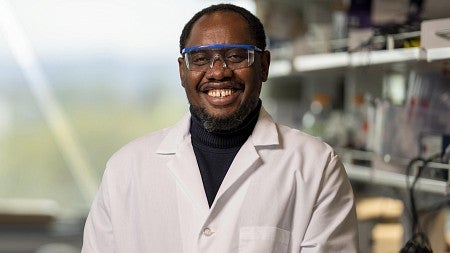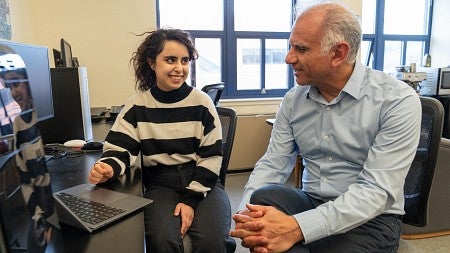
Science and Sacred Monkeys
A sacred monkey in rural Ghana is helping one UO grad student gain insights into the gut microbiome that can have impacts for human health
By Denise Silfee
6 min read
Diana Christie wakes up at 5:00 a.m., tucks her pants into her socks to protect her legs from biting ants, and treks into a Ghanaian forest. She carries a wooden stool and binoculars as the tools of her trade: the stool provides a place to sit for a rest in the forest, and the binoculars help her observe the social behavior of white-thighed colobus monkeys (Colobus vellerosus) to better understand the link between social behavior and the colonies of bacteria that live inside of us.
A PhD candidate in anthropology and the Institute of Ecology and Evolution at the UO, Christie is here six months a year living and working in the Boabeng Fiema Monkey Sanctuary. The small community-run forest preserve sits between the villages of Boabeng and Fiema, 243 miles north of the capital city of Accra and is home to two species of monkey, including the one that Christie studies.
White-thighed colobus monkeys are ideal for Christie’s research examining how social behaviors impact the gut microbiome, or the collection of microbes that live in the digestive tracts of animals.
“We know that the gut microbiome is hugely crucial to health and development and physiological functioning,” Christie said. “But we still don’t know why my gut microbiome looks different than your gut microbiome.”

Increasingly, researchers like Christie are seeing evidence of the the importance of the gut microbiome for everything from digestion to disease prevention and the critical role that social behavior plays in the development of the gut microbiome. UO biologists such as Judith Eisen and Phil Washbourne are examining the topic in the lab by looking at microbiota and the development of social behavior in zebrafish. Christie’s research is different because it looks at a species in its natural environment rather than in the controlled environment of the lab.
Like humans, white-thighed colobus monkeys are social primates, therefore implications from what she learns about the monkeys are more directly translatable to human health. The monkeys live in social groups and regularly groom each other and take afternoon naps together. They also practice allomothering, or the sharing of infant-rearing responsibilities. When a new baby is born, other adult females in the social group immediately show up to hold and help care for it, which increases the amount and variety of social interactions to observe.
In general, Christie says, diet and genetics contribute less to the animal gut microbiome than you might think. When it comes to the microbial makeup of the guts of people who live together, there are similarities that go beyond common food consumption or shared DNA. There are environmental factors at work that appear to be linked to social interactions and the social sharing of gut microbes can even occur across different species living in the same household.
“You share more of your microbiome with your dog than you do with other dogs that don’t live in the same house,” Christie explains.
Scientists still have a lot to learn, but the potential applications of research examining gut health could eventually inform treatments for Alzheimer’s disease, diabetes, some cancers, and many digestive-related disorders. One of the major questions researchers like Christie are seeking to answer is how the gut microbiome develops in the first place.
White-thighed colobus monkeys are critically endangered. No one is sure how many are left in the wild, but their numbers have been steadily declining in their native West Africa due to hunting and deforestation. Sanctuary managers guess there are about 400 colobus monkeys living in the Boabeng Fiema Monkey Sanctuary, and that is believed to be one of the largest remaining intact populations. The monkeys living in Boabeng and Fiema have been successfully preserved because they are important to the traditional religious beliefs of the people who live there. Considered the sacred children of the fetish spirit of Boabeng, called Daworo, the monkeys must be protected.
While Christie hopes her research will help impact what we know about human health, it also contributes to the conservation efforts of the sanctuary. Christie shares her data with sanctuary managers to help them gain more insights into the behavior of these sacred monkeys and into the biological health of the population living at the sanctuary.
On any given day in the sanctuary, Christie can be found looking up into the trees through her binoculars. As she watches the monkeys, who spend most of their days eating and napping, she calls out behaviors to her field assistant, Zany Wynar, a Washington state native, who records the information in an app on an iPad using a long list of lettered codes for behaviors like grooming, resting, look at other monkeys, or “friendly inspect”–when an adult approaches a female with an infant and is welcomed to interact with it.
Additionally, Christie works with two local field techs, Robert Koranteng and Charles Kodom, who help her identify each monkey by name using their distinctive white eyebrows as identifiers. They also help her collect fecal samples, which are used to provide a genomic picture of the monkeys’ gut microbiomes.
“Diana gets very excited about the poop,” Koranteng said with a laugh.
The fecal samples, when cross-referenced with data on the monkeys’ social interactions, help Christie determine how much social behaviors contribute to the transfer of microbes in the gut.
Finding Her Way to Ghana
Ten years ago, Christie was on a different path. While studying premed at the University of Washington she took an anthropology elective on infectious disease. Her passion for the subject was undeniable and she switched her major to anthropology and turned her focus to disease ecology, medical anthropology and global health. Because primatology was a natural lens for her newfound interests, she interned at the Washington National Primate Research Center in Seattle, and then found field positions in Puerto Rico and South Africa. Her interest in the gut microbiome emerged through her own independent reading and research.
Christie’s intersecting interests drew her to the UO and the opportunity to work with Nelson Ting, an associate professor in the Department of Anthropology and the Institute of Ecology and Evolution, whose research includes conservation genomics and host-microbe relationships. Ting has studied the evolutionary relationships between different colobus monkey species, and his lab was primed for someone like Christie who is interested in the microbiome to come along and take the research further.
Christie’s research is interdisciplinary in nature, and so she ended up with two advisors: Ting, and professor Brendan Bohannan, who studies microbial biodiversity, work together to guide Christie’s training in primatology, genetics, and microbial ecology.
“Intellectually, she's had to integrate a lot of different types of knowledge,” Ting said of Christie’s work. “And she’s done that very well.”
Spending so much time in the field can be difficult for Christie. It means she has to miss time with her family and that she isn’t there for important events on campus, like supporting a good friend as they defended their thesis.
But the rewards ultimately make the sacrifices worthwhile.
“Working in Boabeng and Fiema means that I have been able to build relationships with people that I quite literally would have never met otherwise, and many of them have taken me in and treated me like family,” Christie said.
Learn More
Ting Lab Bohannan Research Lab
Boabeng Fiema Monkey Sanctuary
IUCN Red List for Critically Endangered White-Thighed Colobus Monkeys
Pascal Sicotte Lab - University of Calgary
Interactions Between Social Groups of Colobus Monkeys Explain Similarities in Their Gut Microbiomes




